
Throughout almost three decades, Uta Barth has made visual perception the subject of her work. Building up on this, Barth’s Deep Blue Day series explores notions of the atmospheric and ephemeral through light as it shifts over time. Here, for the first time in her practice, Barth overtly manipulates her surroundings by drawing the folds of her living room curtains in order to shape shifting rays of sunlight over the course of an afternoon. While photography is always about light and exposure, this work is a beautiful example of Barth's new engagement with light, where she uses it in an almost sculptural or performative way.


Over the past decade, Math Bass has developed a lexicon of symbols—letters, bodily forms, architectural fragments, animals, bones —arranged in a variety of scores, each symbol an empty space of meaning, filled in by the context in which it finds itself. Repetition of these symbols, rather than codifying them into one solid signification, exposes the difference at the heart of each iteration; there is always a gap in meaning, something unnamable left out of and left over in the viewer’s reading—a jouissance. That these symbols are familiar only heightens our unsettling; the negative space of these compositions, a major player in Bass’s practice, adds further to the gap.


For the past three decades, Monica Bonvicini’s multifaceted practice has confronted issues of institutional critique and the politics of space in relation to gender and power, and more recently, the exploration of reflection, perception, and the interplay of self-reflection, voyeurism, narcissism and self-awareness on both personal and global levels.
Gorgeous (Smoke) is a sculptural and performative wall piece, featuring a colored mirrored surface with an aperture from which an amorphous glass object emerges. The sculpture invites viewers to engage in dual acts of observation and self-reflection. Within its reflective depths, lots of reading and emotions are happening, from captivation and self- expression to a sobering confrontation with the sculpture's stoic and unyielding presence. Yet, the rigidity of the rectangular mirror is disrupted by the intrusion of a glass organ resembling the softness and shape of a tongue.
From communication and language to deviance and pleasure, the tongue stands as a powerful cultural symbol. This work evokes this multilayered intensity, referring to its function not only as an instrument of speech but also as an element integral to knowledge acquisition, sense- making, and imagination. Gorgeous adds another layer to Monica Bonvicini’s decade exploration of reflection in shaping our perceptions, playfully emphasizing how deceptive these can be, particularly when contrasted to oneself image. This engagement is further emphasized by the interplay of voyeurism, narcissism and self-awareness, explored playfully through reflective surfaces that literally stick their tongues out.


Since the early 1990s, Sandra Cinto has explored the potential of drawing to create intricate images and immersive environments, often using the line as gesture to deconstruct physical and spiritual boundaries. Cinto renders a mesmerizing starscape that evokes a sense of weightlessness like that of the sea and the sky. In all her work, Cinto conjures great tensions and contradictions: formally, between surface and depth, abstraction and representation, but also thematically, between joy and sadness, fear and comfort, utopia and reality.


The self-conscious orbital force evolved from a series of sculptures that Eliasson produced in 2019 titled Human time is movement. The variations of spiraling spheres are based on a mathematical figure known as the Clelia curve. Named after the countess Clelia Grillo Borromeo by the early- eighteenth-century Italian mathematician Guido Grandi, the curve traces the progress of a point as it moves simultaneously along a sphere’s meridian and rotates around its axis at a constant speed. The resulting curve corresponds to the way one peels an orange or winds up a ball of wool. The strikingly different forms seen in Eliasson’s works, on the other hand, are produced by adjusting the speeds of rotation and by contracting the curve in towards the centre as the point travels.
In this sculpture, the three-dimensional form of the Clelia curve is illustrated on the flat surface of the wall, modeled as in projective geometry (the mathematical discipline, originating from the study of one-point perspective, concerned with forms as they appear on a plane).
Glass spheres of various sizes trace the contours of the curves, each one featuring half mirror finish and half black coating. The variations in size create an illusion of depth, enhanced by varying degrees of turns on each spheres axis as they ascend and descend along the curves. As the viewers’ eyes trace the contours, they encounter numerous inverted reflections of themselves, their surrounding environment, and other spheres.


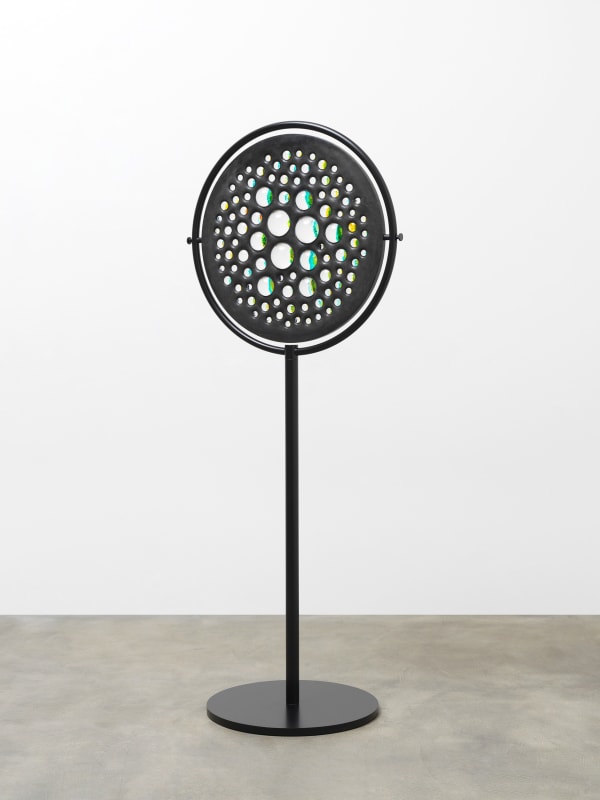

For more than three decades, Mark Manders has developed an endless self-portrait in the form of sculpture, still life, and architectural plans. Described by the artist as his ongoing “self-portrait as a building,” Manders’ works present mysterious and evocative tableaux that allow viewers to construct their own narrative conclusions and meanings. Produced through an intimate logic that has now become signature to Manders' practice. Rendered in cast bronze, the work depicts a figure in what deceptively appears to be a soft clay. In doing so, the artist blurs the line between reality and illusion, and freezes a moment in time, highlighting the fragility of each passing moment. The manipulation of material and scale generates a sense of puzzlement and awe, masterfully creating a sense of timelessness— while the sculpture seems to be just made, it is at the same time enigmatically atemporal.
Mark Manders has a current solo exhibiton at Fondazoine Sandretto Re Rebaudengo in Turin, Italy.


In Yuko Mohri’s Decomposition series, electrodes are inserted into fruit to measure their internal moisture levels, converting changes in resistance caused by withering or rotting, into light.
Minuscule changes occurring inside the fruit directly affect the dimness of the lights, conveying the life of fruit that continues to emerge and evolve even after its connection to the soil or tree trunk has been severed. Hinting at the history of still-life painting, Mohri’s work questions the relation between stillness and liveliness, revealing that what might seem without life is actually full of it.
Yuko Mohri represented Japan in this year’s Venice Biennale. Mohri now has a major solo exhibition, On Physis, at the Artizon Museum in Tokyo, on view through February 9th, 2025. In the fall of 2026, she will have a solo show at Pirelli HangarBicocca in Milan.
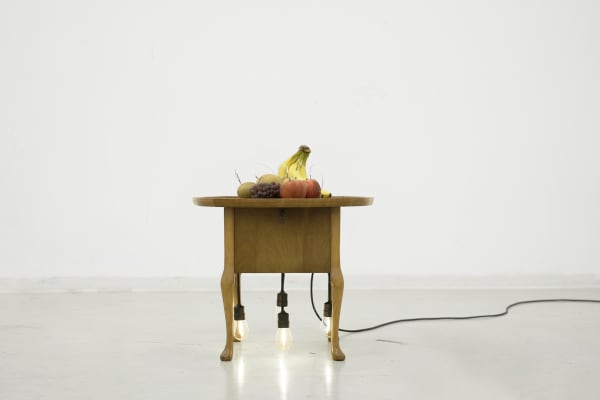

Nathalie Djurberg & Hans Berg’s series of sculptural flowers offer a fragile beauty and an untamable, organic logic of their own. Constructed from mixed media – modeling clay, paint, fabric and resin – the sculptures recall native lilies or orchids, as well as fantastical floral arrangements in other-worldly colors and forms. Flowers are a recurring motif in Djurberg & Berg’s practice, for their abiding interest in the fleeting nature of human emotions and their respective symbolism for emotions like love, joy, desire, sadness and vulnerability, and ultimately, the circle of life. In 2009, the artists created their first major work inspired by flora and fauna, a subversively surreal and immersive Garden of Eden, entitled The Experiment, for the 53rd Venice Biennial, for which they were awarded the Silver Lion for best emerging artists.


Since the mid-1990s, Ernesto Neto has produced an influential body of work that explores constructions of social space and the natural world by inviting physical interaction and sensory experience. Drawing from biomorphism and Minimalist sculpture, along with Neo- concretism and other Brazilian vanguard movements of the 1960s & 70s, the artist both references and incorporates organic shapes and materials that often engage all five senses to renegotiate boundaries between artwork and viewer, the organic and manmade, and the natural, spiritual and social worlds.
With hand braided chita, a traditional Brazilian fabric, woven around wooden pegs, Vibração Contemporosa evokes imagery of dreamcatchers or pathways to create a sense of harmony and tension in both form and energy. In this way, the materiality of the work presents an intuitive meeting point of old and new, traditional and contemporary.

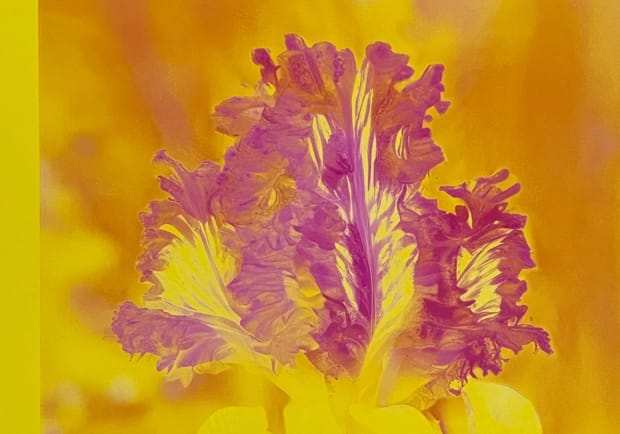
For her forthcoming solo exhibition at MUDAM Luxembourg, opening February 2025, Lisa Oppenheim transforms and embodies the art practice of one of the twentieth century’s most well-known yet enigmatic artists working in and around photography: Edward Steichen (born Edouard Jean Steichen, 1879, Luxembourg — 1973, Redding, Connecticut).
Although today he is most renowned for his innovations in publishing and exhibiting photography, Steichen was also well-known for a similarly experimental approach to the breeding and exhibition of flowers. In 1910, French amateur botanist Fernand Denis created a new Iris hybrid by crossing the species Chameiris Alba and Iberica. He named the new flower Mons. Steichen, presumably in honor of his fellow horticultural enthusiast. There are no known photographs of Mons. Steichen, nor extant examples of the flower. As such, it is impossible to know with any certainty precisely what the iris looked like. Oppenheim’s research led her to realize that, while it was impossible to recreate this flower through traditional techniques, perhaps other means of technological reproduction could be used instead.
Steichen himself embraced new photographic technologies as they emerged, and he even equated his experiments in plant breeding with his approach to photography. One such example can be identified in Steichen’s late-1930s experiments with dye transfer printing. This technique impregnates red, green, and blue photographic matrices with cyan, magenta, and yellow dyes, creating hyper-saturated prints that look like no others. Unlike anyone else at the time (or for that matter since), Steichen also experimented with the process’s “normal” chromatic order, and the results turned the concept of photographic realism on its head, producing quasi-psychedelic renderings of everything from theatrical performances to bouquets of flowers.
Starting from existing photographs of Chameiris Alba and Iberica irises, Oppenheim utilized advanced AI technology to produce new images of hypothetical “offspring” of the two strains. Oppenheim then took up the labor-intensive and now almost entirely outmoded dye transfer process. She has produced analog prints of the AI-generated images with her own “incorrect” color combinations, creating a huge range of possible “Mons. Steichens” that explode the concepts of both genetic and photographic verisimilitude.


In this colorful embroidery, Pica continues her examination of art and understanding, and how this relationship changes over time. Using drawings made by her young son, Pica and her collaborators painstakingly stitch his quick gestures onto fabric, depicting a pre-representational way of conceptualizing the world around us. She highlights the freedom of expression experienced prior to formal schooling, which ultimately changes our way of seeing and conditions the way we perceive our environment. A deliberate tension between the speed with which the drawings are made and the minute care taken to embroider them exists, embodying the lasting psychological effects of childhood, as well as parental labor.


In a series of sculptural photographs titled Landings, Magali Reus twists the tradition of a Dutch still life. Each image centers on a pert fruit photographed within a mise-en-scène of construction debris. Reus created the images by climbing into construction skips in her hometown of the Hague in the Netherlands, positioning fruits among the demolished drywall and splintered floorboards in front of buildings under renovation.
By fusing immaculate fruits and vegetables and the refuse of refurbishment, Reus calls attention to questions of nature and artifice, humanity’s selective breeding and genetic modification of fruits and vegetables, and—in the memento mori spirit of the still-life genre—the ephemerality of life amid the changing seasons.
Always attuned to the material presence of her images, Reus embeds her Landings photographs into sculptural frames of powder-coated steel. Each pigment print is layered over a cropped and desaturated image of a childhood painting: a self portrait of Reus standing in carefully balanced greenery. The coated steel frame carries letters and numbers welded onto its sides along with swatches of tarpaulin and twirled lengths of wire. The letters and numbers convey abbreviations of months and the miles traveled by the crop depicted from its place of harvest to its consumer. Through abbreviation and initializing these meanings become obscured.


Sherrill Roland’s work 168.828, gives visual form to vivid memories of the ten months he spent wrongfully incarcerated. In this steel sculpture, Roland recalls the experience of spending day after day in prison, when he would often pass the time by tracing the outlines of the white cinder blocks, which measured 8 x 16 x 8 inches and formed his two-man cell. The repetitive, tactile action became a method of meditation that offered a mental escape to the freedom beyond the physical confines of the prison cell.
In 168.828, Roland references the repetition of mindlessly tracing the cinderblocks to fight against the collapse of mental stability. Roland fills the channels with resin mixed with Kool-Aid, drawing our attention to the line and the space between it. As the background color of the channels shift from white to black, the change creates an undertone for the Kool-Aid, altering the tones of the flavors.


Analia Saban dissects and reconfigures traditional notions of painting, often using the medium of paint as the subject itself. Blurring the lines between painting and sculpture, imagery and objecthood, her work frequently includes plays on art historical references and traditions. Paintings expand to sculptural forms and sculptures are presented in two dimensions, using the process of trial and error with new techniques and technology. Her unconventional methods such as unweaving paintings, laser-burning wood and canvas and molding forms in acrylic paint remain central to her practice as she continues to explore art-making processes and materials in relation to her daily experience. Dealing with issues of fragility, balance, technique and experimentation, Saban's connection with everyday objects is at the forefront of her investigation of tangible materials and the metaphysical properties of artworks.
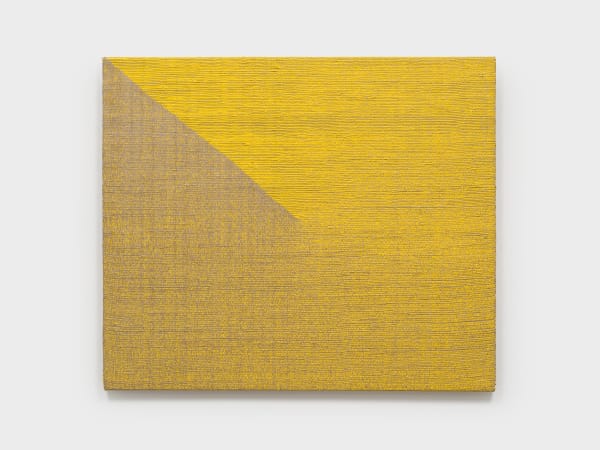

Informed by the worlds of art, architecture, natural sciences and engineering, Tomás Saraceno’s floating sculptures and interactive installations propose new, sustainable ways of inhabiting the environment. Embodying one of the core concepts in Saraceno's work and reimagined with a new reflective and multicolored material, HD 203030 b/M+M presents a model of life floating in space and suggests an architectural vision of the future. Suspended from the ceiling like a cloud, the complex geometric shape of the modules are derived from the artist's continued experimentation with a structure termed the "Weaire-Phelan Model," which describes an idealized mathematical geometry of foam. The work’s vibrant colors, however, tie it more firmly to the terrestrial realm; the ochres, golds, browns, blues and reds represent the life and dynamism of organic matter, and evoke the tones of land, sea, vegetation, and sky.

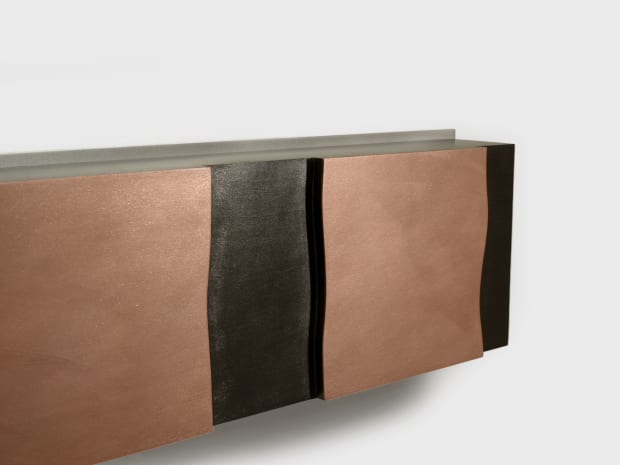
With an interest in forming a language through concise material abstraction, Lisa Williamson creates works that are visually precise, physically resonant, and often attune to the spaces in which they are exhibited. Plateaus vast horizontal expanse is a machine-carved basswood relief mounted to aluminum, and painted by hand in layers of semi-transparent shimmering metallics. While there is a significant level of reduction and abstraction throughout the artist’s work, aspects of architecture, landscape or the figure remain visible throughout.
